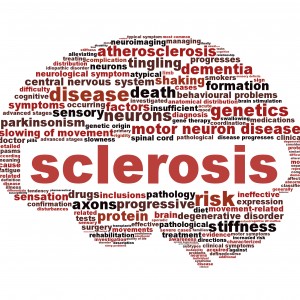Spinal Cord Alteration in Multiple Sclerosis Could Lead to New Therapeutic Target

 A recent study led by researchers at the Centre for Addiction and Mental Health (CAMH) in Toronto, Canada revealed a promising new method for multiple sclerosis (MS) treatment. The study was published in the journal Annals of Clinical and Translational Neurology and is entitled “Blocking GluR2–GAPDH ameliorates experimental autoimmune encephalomyelitis.”
A recent study led by researchers at the Centre for Addiction and Mental Health (CAMH) in Toronto, Canada revealed a promising new method for multiple sclerosis (MS) treatment. The study was published in the journal Annals of Clinical and Translational Neurology and is entitled “Blocking GluR2–GAPDH ameliorates experimental autoimmune encephalomyelitis.”
MS is a progressive, immune-mediated disorder in which the body’s own immune system attacks the central nervous system (brain and spinal cord nerves). The exact causes for MS are not clear but the fact that the immune system is involved makes it a target for current therapies that address immune system responses. While the medications used in these therapies are not curative, they can help relieve the disease symptoms and slow its progression.
Researchers have identified a previously unknown spinal cord alteration linked to MS related to a protein called GAPDH (glyceraldehyde 3-phosphate dehydrogenase, a protein important in glucose metabolism) and a specific cell receptor for the glutamate neurotransmitter (the major excitatory neurotransmitter in the brain, critical for normal brain function). GAPDH was found to interact with this glutamate receptor, called the AMPA receptor, at higher levels in postmortem spinal cord tissues of MS patients and also in MS animal models. The AMPA receptor has been previously suggested as being able to mediate the cytotoxicity linked to the loss of neurons. Researchers therefore hypothesized that blocking AMPA-GAPDH interactions could be therapeutic for MS.
[adrotate group=”4″]
“We’ve identified a new biological target for MS therapy,” said the study’s senior author Dr. Fang Liu in a news release. The team discovered an approach to changing this alteration in order to stop nerve cell damage and also improve motor problems usually linked to the disorder. They developed a new peptide (a small piece of protein) to block the interaction between GAPDH and the AMPA receptor, more specifically GAPDH -GluR2 subunit of the AMPA receptor, and tested it in MS animal models.
“We found that our peptide disrupted this linkage, and led to major improvements in neurological functioning,” explained Dr. Liu. Mice treated with the peptide had their motor function significantly improved and a lower rate of neuron death along with myelin restoration, the protective coating of neurons important for the normal transmission of nerve impulses. More importantly, the peptide developed was found to be different from drugs targeting the glutamate system as it did not directly suppress the immune response of the body, which is a common side effect of many glutamate drugs.
The team believes that the GluR2-GAPDH complex could be a novel target for the development of new types of MS therapies that exploit a different mechanism from those currently used in treatments. “Our priority now would be to extend this research and determine how this discovery can be translated into treatment for patients,” concluded Dr. Liu.






